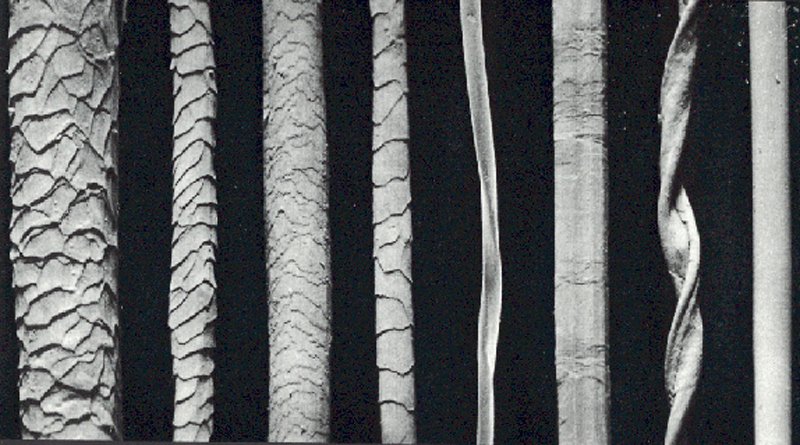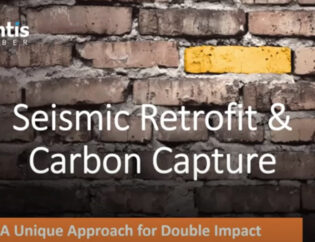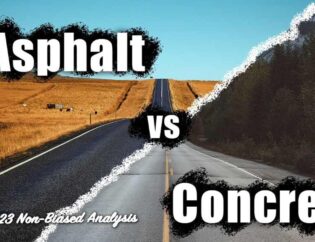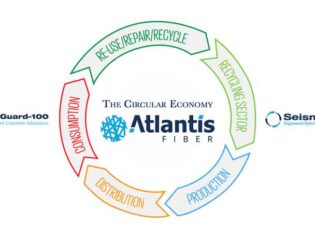
Not all fibers are the same. At approximately 1/5th the energy required to extract and process scrap tire fiber (STF) compared to that of petroleum-based virgin fiber, AlantisFiber™ widens the gap between the competition even more.
Double-Dipping In Environmental Impact
In addition, at AtlantisFiber™, we’re concerned about all our processes through the lens of environmental impact. We source our fiber from a large network of recycling facilities spread across North America making shipping and logistical processes that much more efficient — further reducing our carbon footprint through the reduction of fuel energy and pollution.
A key driver for us is to make the most of the unique advantages that we enjoy based on our extensive network of recycling facilities. “It’s one thing to produce a great, environmentally friendly product and quite another to ensure that all the supporting infrastructure that surrounds it is equally well balanced,” says Pat McConnell, President & CEO at AtlantisFiber™
 What Makes Our Recycled Tire Fiber Unique?
What Makes Our Recycled Tire Fiber Unique?
Concrete structures tend to develop cracks over time, but the polymer fibers used by AtlantisFiber™are bridging the cracks as they form, helping protect the structure and making it last longer. We can do this because we have discovered that the extracted fibers form a structural bond within the concrete mixture for added strength, longevity, and a host of anti-cracking performance properties.
The researchers at the University of British Columbia (UBC), Vancouver, Canada, experimented with different proportions of recycled polymer tire fibers and other materials used in concrete — cement, sand and water — before finding a working mix, according to researcher Obinna Onuaguluchi, a postdoctoral fellow in civil engineering at UBC. The result, in 2017, was that using the polymer fibers from recycled tires greatly improves the resilience and lifespan of the concrete.
“Our lab tests showed that fiber-reinforced concrete reduces crack formation by more than 90 percent compared to regular concrete. Concrete structures tend to develop cracks over time, but the polymer fibers are bridging the cracks as they form, helping protect the structure and making it last longer.” ~ Dr. Obinna Onuaguluchi, a postdoctoral fellow in civil engineering at UBC
So, Where Do We Go From Here?
At AtlantisFiber™, research surrounding recycled tire polymer fibers in concrete is ongoing and a concerted worldwide effort is at play according to an abstract titled “Influence of recycled tire polymer fibers on concrete properties” by Ana Baričević, Marija Jelčić Rukavina, Martina Pezer, NinaŠtirmer at the University of Zagreb Faculty of Civil Engineering, Department of Materials, Fra Andrije Kacica Miosica 26, 10 000 Zagreb, Croatia. In it, they describe “early age deformations, and freeze-thaw resistance is part of our ongoing research.”
EXCERPT: “In an effort to meet the goals of the 2030 Agenda for Sustainable Development — a United Nations Resolution adopted by the General Assembly on 25 September 2015, Transforming Our World: the 2030 Agenda for Sustainable Development — while simultaneously reducing the consumption of non-renewable resources, more and more research is focused on the application of waste materials in construction products. Due to insufficient knowledge of their properties and impact on structural performance, waste materials are often unfairly marginalized. This is certainly a consequence of current regulations which do not allow the simple application of locally available materials and often imply requirements for unjustified high safety margins.” ~ Abstract – Influence of recycled tire polymer fibers on concrete properties
The abstract goes on to say: “For example, reinforcing concrete with fibers is not an innovative technique. Nowadays, specification, performance, production and conformity of fibers for concrete are strictly prescribed. Nevertheless, in the past few years, new fiber types have been examined and their applications in concrete have been investigated. Recently, the use of waste tires and its constituents (steel and polymer fibers, rubber granules) in concrete production technology has been increasingly studied. However, prior to their utilization in construction products, such materials require characterization which will demonstrate their properties and assure positive long-term behaviour, especially when exposed to aggressive environmental conditions.”
If you have any questions, you can find technical data here or you can reach out to connect and we can have a conversation.
 What Makes Our Recycled Tire Fiber Unique?
What Makes Our Recycled Tire Fiber Unique?








